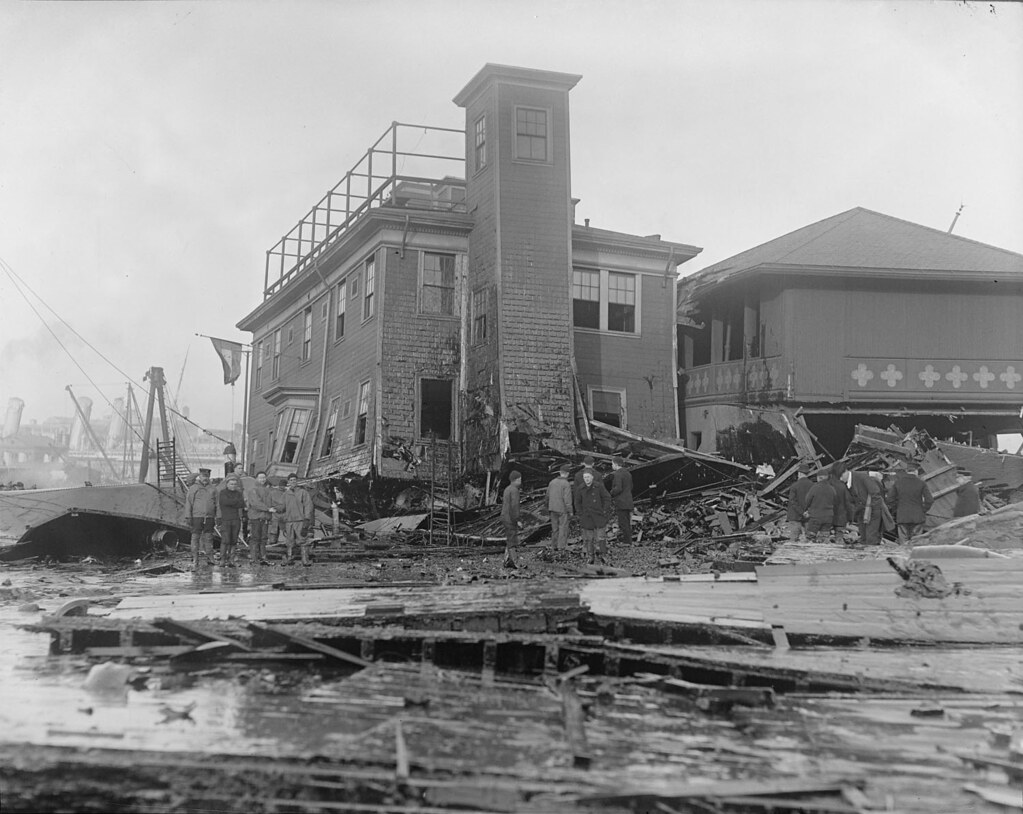Floods are awful in any form and I don’t wish to diminish or make light of that one overriding consideration. However there are floods of a “normal” variety — if an event so awful can be referred to so cavalierly — and then there are the truly bizarre. Either way, it leaves behind lost lives, damaged property and disrupted communities. However, things seem to be a little different and particularly undignified in certain circumstances. For example, when the flood is a raging torrent of molasses.
The Great Molasses Flood of 1919

A large storage tank of molasses filled by the Purity Distilling Company burst in Boston’s North End in January 1919. An official inquiry failed to establish a definitive reason. So they ascribed it to an “Act of God”. Investigators offered several theories over the years including a buildup of carbon dioxide in the tank. That could have happened because it was an unusually warm winter day. Very recently the Boston Globe reported another possibility:
“Now, a study has shed new light on the cause of the collapse, finding that the tank was stressed well beyond capacity and made from a steel susceptible to fracture — the same type used on the Titanic… The steel was too thin to withstand the enormous stress of 2.3 million gallons of molasses, a weakness builders should have known at the time… What builders at the time could not have known was that the type of steel used for the tank was brittle because it contained a low amount of the chemical element manganese, making it more likely to crack.”
The bursting tank sent a huge wave of molasses into the neighborhood. Different sources pegged the wave at between 25 and 40 feet (8-12 metres) high. It slammed into homes, twisted an elevated railroad track, knocked a firehouse off of its foundation, and killed 21 people in its sticky wake. It also left another 150 people injured. Local residents swore they could still smell a hint of molasses on particularly hot summer days for years afterwards.
The Commercial Street location where the tank once stood eventually became the infield of a baseball diamond at Langone Park (map). A small plaque reminds Little Leaguers® of the molasses tragedy.
The London Beer Flood of 1814

How did I miss the 200th anniversary of London’s beer flood? The Independent knew about it and commemorated it though:
“An unlimited, free supply of beer – it sounds wonderful doesn’t it? But when it is over one million litres in volume and in a tidal wave at least 15 feet high, as it was in the London Beer Flood on 17 October 1814, the prospect seems less appealing… a broken vat at the Horse Shoe Brewery on Tottenham Court Road flooded the local area with porter, a dark beer native to the capital, killing eight people and demolishing a pair of homes.”
The brewery operated in an underprivileged neighborhood, a slum called St. Giles Rookery. The flimsy buildings couldn’t withstand the onslaught of beer. Here, people crammed into the tenements all the way down to the cellars. Unfortunately, that’s where much of the tragedy occurred. Those in cellars couldn’t escape as beer poured in and filled to ground level.
Investigators also ascribed this tragedy to an Act of God. However, witnesses reported signs of an impending rupture earlier in the day. The owner, Henry Meux, even managed to get a favorable ruling that allowed him to get a refund on the taxes he’d paid on the beer. Negligence had much different standards back in those days.
The Horse Shoe Brewery (image) dated to 1764. One might think that perhaps this tragedy would have closed the brewery. It didn’t. Horse Shoe hummed along for another century and more, all the way until 1921. Upon closing, the land went to a completely different use. It became the site of the Dominion Theatre, built in 1928-29 (map).
The Swine Sewage Flood of 1999

Conditions in tidal North Carolina were favorable for hog farming. Even so, this industry also had a dirty underside [link no longer works], the bodily wastes of millions of pigs:
“North Carolina’s 10 million hogs produce 40 million gallons of manure each day — that’s more than the number of people in the state. In Duplin County alone, 2.2 million hogs produce twice as much untreated manure as the sewage from the New York City metro area.”
Manure lagoons stored the resulting wastes. These open pits encouraged anaerobic digestion of organic material during storage when operated properly. They are also susceptible to spills if not constructed and maintained adequately.
Hurricanes do hit North Carolina periodically and that’s what happened with Hurricane Floyd in September 1999. A much weaker Hurricane Dennis hit the same area less than two weeks earlier. So the water table was already up and the ground completely saturated. Floyd slammed into the coast right at North Carolina’s Cape Fear region before moving into the Mid-Atlantic and up into New England. It doused eastern North Carolina with tremendous rainfall as it passed, leading to widespread flooding throughout the area.
The noxious sewage deluge polluted many of the local rivers and estuaries. Then it spread fecal coliform bacteria, polluted wells and created dead zones were most aquatic life could not survive. It hit the New River (map) especially hard all along its fifty mile course that took it directly past US Marine Corps Base Camp Lejeune before flushing into the Atlantic Ocean.
All of these undignified floods had something in common: they were completely preventable.

Leave a Reply